 Prepare for the Spatial Reasoning Test
Prepare for the Spatial Reasoning Test
Spatial reasoning refers to understanding reason and remembering spatial relations among objects and space. Spatial reasoning is also called spatial visualization, spatial ability, and spatial intelligence.
The spatial Reasoning test is an aptitude exam that measures spatial abilities, such as thinking about objects in 3D and drawing conclusions about those objects from limited information.
Here, you can find guides and practice questions to help you ace your Spatial Reasoning test.
What Is a Spatial Reasoning Test?
A spatial reasoning test is an aptitude exam designed to evaluate your spatial abilities and capability to visualize, manipulate, and analyze objects in space. These tests measure how well you can understand and mentally rotate shapes, identify patterns, and interpret two- and three-dimensional figures. Spatial reasoning skills are essential in fields such as engineering, mechanics, and aviation, where the ability to think about objects in different orientations and predict how they will interact is crucial.
What Skills Do Spatial Reasoning Tests Measure?
Spatial reasoning tests measure four common types of spatial abilities: spatial or visuospatial perception, spatial visualization, mental folding, and mental rotation. People with high visual-spatial intelligence are good at remembering images, faces, and fine details, which will help them excel on this test.
- Spatial or visuo-spatial perception – This type of spatial reasoning refers to the ability to perceive spatial relationships in respect to the orientation of one's body despite distracting information. Spatial information includes features, properties, measurements, shapes, positions, and motion. This ability is sometimes used in Map/Floor Reading.
- Spatial visualization – This type of spatial reasoning refers to the ability to mentally represent visual appearances of an object and spatial imagery, which consists of mentally representing spatial relations between the parts or locations of the objects or movements. This skill is sometimes measured through Matching Parts type questions.
- Mental Folding—This type of spatial reasoning involves complex spatial visualization, which involves folding 2D patterns or materials into 3D objects and representations. This ability can be seen in Understanding patterns-type questions.
- Mental Rotation – This type of spatial reasoning refers to the ability to mentally represent and rotate 2-3 dimensional objects in space quickly and accurately, while the objects features remain unchanged. Rotated Blocks is a perfect example of mental rotation.
Spatial Reasoning Test Questions
Spatial Reasoning Test Question #1 - Map/Floor Reading
This section asks test takers to locate points and routes of specific locations on floor plans, maps, or pictures. These types are questions are usually found on firefighter or police officer exams. During the test, it may be required to memorize the image, after which questions will be asked based on the image.
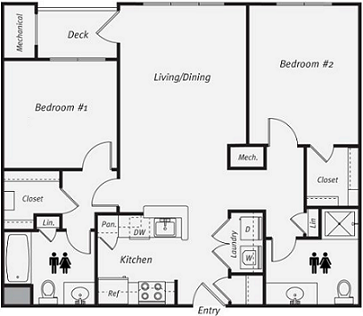
Spatial Reasoning Test Question #2 - Understanding Patterns
These questions measure the ability to transform two-dimensional figures into three-dimensional figures and vice versa.
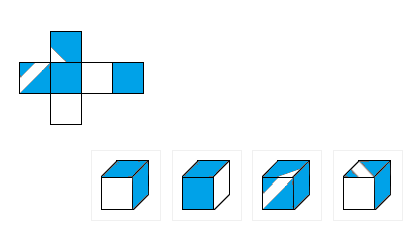
Spatial Reasoning Test Question #3 - Matching Parts
This spatial visualization question measures a candidate's ability to mentally turn, flip, and piece shapes together. This skill is used in mechanical tests specifically for when dealing with parts.
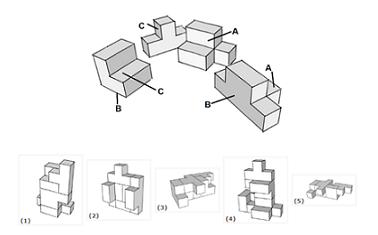
Spatial Reasoning Test Question #4 - Rotated Blocks
This section requires test takers to identify which rotated shape among the answer choices is the same as the original shape in the question.
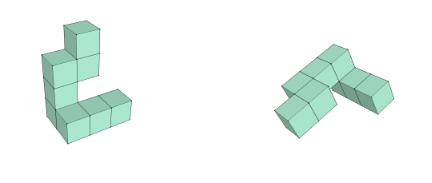
Spatial Reasoning Test Question #5 - Flexibility of Closure
This type of question measures the ability to identify a pattern buried within a large and cluttered image. This skill is particularly used in police work.
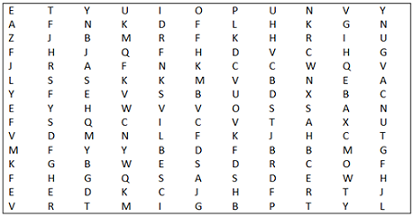
Other Types of Spatial Reasoning Test Questions
- Spatial Analysis – This sections asks questions that measure the ability to take different spatial views and mentally combine them into a three-dimensional figure.
- Block Counting – These questions require the test taker to count three-dimensional blocks, which may be visible or hidden.
- Identifying Hidden Figures – The questions in this section require candidates to find geometric shapes placed inside more complicated figures.
- Hand-Eye Coordination – This type of question comes in three different formats:
- Letter-symbol coding – This section requires the identification of codes that are hidden in symbols and letters.
- Inspection tests – This section requires a close analysis of a given figure and to answer questions relating to the figure. (Ex: How many squares are found in columns A and B of the figure?)
- Examining objects and mazes – Given objects are examined and classified according to a given set of codes or rules.
For more examples, take a Raven's Matrices practice test, or the SHL practice test.
Prepare for Your Spatial Reasoning Test!
Are you aiming to excel in spatial reasoning tests but need help getting ready? Boost your skills and confidence with our comprehensive Spatial Reasoning Test Preparation pack. This bundle includes:
- 24 practice tests
- Interactive study guide
- 14 full simulations tailored for tests like USPS 955 and TSA
- Hundreds of questions and detailed explanations
So what are you waiting for?
Jobs with Spatial Reasoning
Spatial reasoning tests vary depending on the position or field they are intended for. This allows employers to assess if applicants have the specific spatial intelligence needed for a particular job.
For instance, many public safety positions—such as firefighters, police, and 911 dispatchers—require a good working knowledge of how to find a relationship between different objects or figures. When applying to a public safety position, candidates may see the spatial ability section referred to as spatial orientation.
Spatial reasoning tests are also often used in recruiting engineers, architects, chemists, airplane pilots, and more.
How Are Spatial Reasoning Tests Used?
Spatial ability tests and spatial reasoning tests are used for different pre-employment hiring processes.
- An engineer must mentally visualize the interactions of the parts of a machine or building that he or she is assigned to design or work with.
- A mechanic must understand the relations and mechanics inside of a car as he or she relies on spatial perception to understand the car's visual framework.
- A police officer or firefighter must be able to identify the most efficient route to drive from one location to another. Candidates should also be able to imagine how something would look if it were moved around or if its parts were moved or rearranged. They are also confronted with diagrams or floor plans, which may be a mirror image or some other variant of an area.
By becoming familiar with how spatial abilities are utilized on the test, you become more prepared for the actual exam. Our practice tests are designed to help you succeed so that you can get the position you desire.
Prepare for Spatial Reasoning Tests
Spatial reasoning tests are becoming a more integral part of the job recruitment process. Today, more than 70% of employers use assessment testing as competition for desirable roles grows. Therefore, preparing for the test has become crucial. JobTestPrep provides practice packs that include practice tests, score reports, and detailed answers explanations. These materials cover all the necessary skills you need to succeed on spatial ability tests. Start preparing today so that you can successfully pass the exam.
FAQs
Spatial reasoning is the ability to understand, interpret, and manipulate shapes and objects in space. It involves mentally visualizing objects, their movements, and the relationships between them in different orientations and dimensions. This skill is crucial in many everyday tasks, such as navigating through a city, assembling furniture, or understanding maps.
Spatial reasoning is often tested through tasks that require you to mentally rotate objects, recognize patterns, or visualize how different shapes fit together. These skills are particularly important in fields like engineering and aviation, where a strong understanding of spatial relationships is essential.
The spatial reasoning test is a type of aptitude test that evaluates the ability to visualize, manipulate, and analyze objects in space. It measures how well you mentally rotate shapes, identify patterns, and interpret two-dimensional and three-dimensional figures.
An example of spatial reasoning is solving puzzles that involve fitting various shapes together, like in Tetris, or assembling a piece of flat-pack furniture by imagining how the parts fit together based on the instructions.
Spatial reasoning IQ refers to the component of intelligence that measures one's ability to visualize, manipulate, and understand spatial relationships between objects. It involves skills such as mental rotation, pattern recognition, and spatial problem-solving, commonly assessed in IQ tests like Raven's Progressive Matrices or block design tasks.
To prepare for a spatial reasoning test, practice regularly with sample questions and familiarize yourself with common question types like mental rotation and pattern recognition. Engage in activities that enhance spatial awareness, such as puzzles, drawing, or playing video games like Tetris. Focus on improving both speed and accuracy, review any mistakes to learn from them, and ensure you stay calm and focused during the test. Consistent practice will build your skills and confidence, helping you perform better on the test.